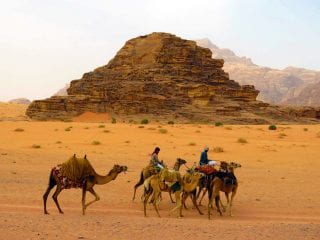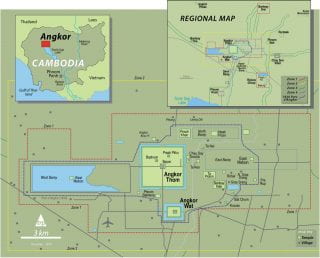A Q&A with Geosciences and Middle East Studies’ Tom Paradise
 Tom Paradise, Ph.D.
Tom Paradise, Ph.D.
University Professor of Geosciences and Middle East Studies
In this conversation, Paradise talks about his eclectic passions and research spanning science, art, architecture and the environment; his adventures in Petra and Wadi Rum, Jordan as well as in California, Hawai’i and Italy; his love of family, cooking and his students; creating more than 3,000 published maps over three decades; collecting and studying gemstones from across the world; and collaborating with multiple TV networks to create specials or series including “Petra, Lost City of Stone,” which is one of the most watched PBS specials with viewership now exceeding 100 million!
Q: Tell us a little about your research, academic passions and/or role within the college. What excites you about this?
My passions have always been eclectic, and so, increasingly my research strives to link rather than focus.
I have loved the Earth and environmental sciences since I was a kid, collecting rocks across North America and Europe, backpacking among the Redwoods of Northern California or the Dolomite Mountains with my dad, visiting Baroque Churches and Roman ruins in Italy, centering clay on a potter’s wheel or forging gold jewelry, and walking around San Francisco (my hometown). So, in the rare world of a university community, I am often able to merge these interests in teaching, service, and research.
Having worked in Petra and Wadi Rum, Jordan since 1990, many of these interests have melded into a three-decade research agenda of examining the deterioration of architecture in Jordan and Rome and also analyzing new gem-minerals occurrences locally and worldwide – such as the famous quartz crystals of Mount Ida and Blue Springs, and the newly discovered fine turquoise veins near Mena.
 So, science, art, architecture, and the environment can and should be merged into a vital curriculum, within ONE department or ONE college; the Department of Geosciences and Fulbright College can and does often link them well.
So, science, art, architecture, and the environment can and should be merged into a vital curriculum, within ONE department or ONE college; the Department of Geosciences and Fulbright College can and does often link them well.
Q: How long have you been at Fulbright College? What have you enjoyed most about your time here?
I arrived in August 2000 from the University of Hawai’i, teaching in geosciences and Middle East studies since the beginning… with a number of those years abroad as a two-year Fulbright Senior Scholar in Jordan (1997-1999), working over two semesters with the U of A Rome Center, and working at the Vatican in 2009-2010 on their restoration of the Bernini’s magnificent colonnaded piazza at St. Peter’s Basilica.
However, I’ve especially enjoyed the camaraderie of my department, where I met my wife, Fiona Davidson, in a friendly and supportive setting, AND the chance to work, teach, and study abroad.
My research in Petra and Wadi Rum in Jordan, has taken me overseas for many summers and school years for fieldwork alone and with students, and that has kept me sane (somewhat), happy, healthy, and academically relevant. Once you experience the great beauty and mystery of Petra and Wadi Rum, you always return!
 Also, Wadi Rum, like Petra, is where a lot of new films involving Mars, or other worlds are filmed…
Also, Wadi Rum, like Petra, is where a lot of new films involving Mars, or other worlds are filmed…
The Martian, Star Wars: The Rise of Skywalker, Rogue One, Dune … and of course Lawrence of Arabia.
I’ve now written 50-plus papers, reports, chapters, etc. on Petra, Wadi Rum, and architectural deterioration, and wrote the 1997 UNESCO inscription for Wadi Rum as a World Heritage Site. It was the FIRST such site that is BOTH a unique cultural and physical site of global importance.
And I JUST finished the English version of the new Petra Museum Visitors Guidebook!
Q: What do you most hope your students remember from their classes and/or interactions with you?
I hope my students remember, appreciate, and reignite in others that same passion and enthusiasm I feel … and not just from/for academics, but in/from life completely.
A great mentor told me that teaching should never be about “teaching” but should always be about “sharing.” I hope that I share always…
Q: What do you like to do during your time outside of the university?
Coming from an Italian and French-Canadian family, cooking is one of those passions that unite family, friends, and strangers. I’ve baked bread weekly since I was 10, and using old San Francisco sourdough starters, it only gets better and better. Fresh pasta is another part of our family with fresh pesto, ‘sugo Bolognese’, and biscotti never far behind.
 My need for art (seeing, creating, experiencing) has always been close-by, and teaching cartography has satisfied many of those passions as well since it is the rare world that merges art and science … and continues to do so.
My need for art (seeing, creating, experiencing) has always been close-by, and teaching cartography has satisfied many of those passions as well since it is the rare world that merges art and science … and continues to do so.
With more than 3,000 published maps over three decades, to continue making maps for clients worldwide, has kept me awake, alive, and passionate about our landscapes, even when it involves a late-night rush to finish UNESCO’s Angkor Wat or Pompei Visitors Maps, or the City of Jerusalem’s Visitor Guide.
Gemstones and mineral specimens are always in the hectic mess somewhere too – teaching the Geology of Gemstones class for the Department of Geosciences or showing elementary school kids around the department and office specimens has always been a special treat. Gemology and gemstone collecting is always a fun, big part of that passion whether on campus, in the field, or at home.
Q: What’s up next on the horizon for you?
I miss having grown up at the sea and in the Wine Country of Northern California. So, summertime on the Mendocino Coast has been a part of our family time (in between fieldwork in Jordan) over the years, so retiring there is definitely a big part of our future.
Jokingly labeled as “Where the wine and weed meet the waves,” the landscape of the Northern California coast is unique in its feel, food, people, and air. Hopefully, it’ll be home once we decide to leave Arkansas and return to my family’s roots.
However, I will continue to do work for the nature TV channels as well. Having done nine television specials or series on nature, Jordan, North Africa and the Middle East, ancient architecture, and cartography, I hope to continue script work, mapping, research, voiceovers, and on-air commentary for many of the networks I’ve collaborated with including The National Geographic Society (NatGEO), Smithsonian Channel, PBS Nova, and Discovery Channel.
So, I hope to continue this fun and crazy work. Nova’s Petra, Lost City of Stone remains one of the most watched PBS specials with viewership now exceeding 100 million!
Q: Is there anything else you’d like to add or let readers know?
I grew up with the adage “Only the mediocre are always at their best” … so I’ve embedded that notion in my work and play, and the same for my students. When we are scared to try something new, or push harder to excel or innovate, we only lag behind and dilute the passion.
I also see it admirably in my daughter, Sam, who is an extraordinary student and horse rider (cavaliere). She strives to jump higher, ride better, train the horses precisely, and love what she is doing along the way.
What more can we expect from ourselves, our families, and our students but to excel, become aware of our physical, cultural, and human landscapes, and LOVE the process, people, and place at the same time?










